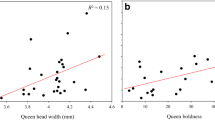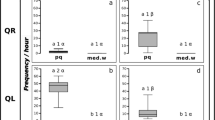Abstract
Parent–offspring conflict theory predicts conflict between parents and their offspring over per-offspring resource investment. Across the range of the desert seed-harvester ant, Messor pergandei, daughter queens use three different social strategies during colony founding that are expected to alter the optimal level of parental investment. To test whether social strategy variation is associated with shifts in body mass, we surveyed queen live mass over 3 years at 25 sites that spanned the range of behavioral strategies and founding group sizes. To test whether reduction in parental investment into individual offspring negatively impacts their productivity, queens were individually isolated and allowed to produce a single worker cohort under common garden conditions. Queen live mass was highly variable, from 24 mg on average at the site with the lightest queens to 1.5 times that size, 37 mg, at the site with the heaviest queens. As predicted by parent–offspring conflict over investment, solitary colony founding sites contained the heaviest queens, followed by secondary monogyny. Polygynous queens were lightest, with a strong negative relationship between group size and live mass. Reductions in body mass had a negative effect on queen productivity across all queen social types; however, queens from sites where queen–queen aggression is typical were significantly more efficient at brood rearing, resulting in lower mass loss during founding per unit offspring biomass. This may represent an adaptation to queen competition to gain a strength advantage over potential rivals.






Similar content being viewed by others
References
Aron S., Steinhauer N. and Fournier D. 2009. Influence of queen phenotype, investment and maternity apportionment on the outcome of fights in cooperative associations of the ant Lasius niger. Anim. Behav. 77: 1067-1074
Balas M.T. and Adams E.S. 1996. The dissolution of cooperative groups: mechanisms of queen mortality in incipient fire ant colonies. Behav. Ecol. Sociobiol. 38: 391-399
Bangham J., Chapman T. and Partridge L. 2002. Effects of body size, accessory gland and testis size on pre- and post-copulatory success in Drosophila melanogaster. Anim. Behav. 64: 915-921
Bernasconi G. and Keller L. 1996. Reproductive conflicts in cooperative associations of fire ant queens. Proc. R. Soc. Lond. B 263: 509-513
Bernasconi G. and Keller L. 1998. Phenotype and individual investment in cooperative foundress associations of the fire ant, Solenopsis invicta. Behav. Ecol. 9: 478-485
Berrigan D. and Charnov E.L. 1994. Reaction norms for age and size at maturity in response to temperature: a puzzle for life historians. Oikos 70: 474-478
Blanckenhorn W.U. 2000. The evolution of body size: what keeps organisms small? Quart. Rev. Biol. 75: 385-407
Bonduriansky R. and Head M. 2007. Maternal and paternal condition effects on offspring phenotype in Telostylinus angusticollis. J. Evol. Biol. 20: 2349-2388
Brown M.J.F and Bonhoeffer S. 2003. On the evolution of claustral colony founding in ants. Evol. Ecol. Res. 5: 305-313
Espadaler X. and Rey S. 2001. Biological constraints and colony founding in the polygynous invasive ant Lasius neglectus. Insect. Soc. 48: 159-164
Fox C.W. and Czesak M.E. 2000. Evolutionary ecology of progeny size in arthropods. Annu. Rev. Entomol. 45:341-369
Hadley N.F. 1994. Water Relations of Terrestrial Arthropods. Academic Press, San Diego
Hahn D.A., Johnson R.A., Buck N.A. and Wheeler D.E. 2004. Storage protein as a functional marker for colony-founding strategies: A comparative study within the harvester ant Pogonomyrmex. Physiol. Biochem. Zool. 77: 100-108
Helms K.R. and Helms Cahan S. 2012. Large scale regional variation in cooperation, conflict, group size, and cooperative breeding among queens of the desert ant Messor pergandei. Anim. Behav. 84: 499-507
Helms K.R., Newman N.J. and Helms Cahan S. 2013. Regional variation in queen and worker aggression in incipient colonies of the desert ant Messor pergandei. Behav. Ecol. Sociobiol. doi:10.1007/s00265-013-1568-8
Helms Cahan S. 2001. Co-operation and conflict in ant foundress associations: insights from geographical variation. Anim. Behav. 61: 819-825
Helms Cahan S. and Helms K.R. 2012. Relatedness does not explain geographic variation in queen cooperation in the seed-harvester ant Messor pergandei. Insect. Soc. 59: 579-585
Helms Cahan S. and Rissing S.W. 2005. Variation in queen size across a behavioral transition zone in the ant Messor pergandei. Insect. Soc. 52: 84-88
Honek A. 1993. Intraspecific variation in body size and fecundity - a general relationship. Oikos 66: 483-492
Howard K.J. 2006. Three queen morphs with alternative nest-founding behaviors in the ant, Temnothorax longispinosus. Insect. Soc. 53: 480-488
Johnson R.A. 2000a. Habitat segregation based on soil texture and body size in the seed-harvester ants Pogonomyrmex rugosus and P. barbatus. Ecol. Entomol. 25: 403-412
Johnson R.A. 2000b. Reproductive biology of the seed-harvester ants Messor julianus (Pergande) and Messor pergandei (Mayr) (Hymenoptera: Formicidae) in Baja California, Mexico. J. Hym. Res. 9: 377-384
Keller L. and Genoud M. 1997. Extraordinary lifespans in ants: a test of evolutionary theories of ageing. Nature 389: 958-960
Keller L. and Passera L. 1989. Size and fat-content of gynes in relation to the mode of colony founding in ants. Oecologia 80: 236-240
Kim J.Y. 1997. Female size and fitness in the leaf-cutter bee Megachile apicalis. Ecol. Entomol. 22: 275-282
Kim J.Y. and Thorpe R.W. 2001. Maternal investment and size-number tradeoff in a bee, Megachile apicalis, in seasonal environments. Oecologia 126: 451-456
Kingsolver J.G., Diamond S.E., Seiter S.A. and Higgins J.K. 2012. Direct and indirect phenotypic selection on developmental trajectories in Manduca sexta. Funct. Ecol. 26: 598-607
McCue M.D. 2010. Starvation physiology: Reviewing the different strategies animals use to survive a common challenge. Comp. Biochem. Physiol. A 156: 1-18
Meunier J. and Chapuisat M. 2009. The determinants of queen size in a socially polymorphic ant. J. Evol. Biol. 22: 1906-1913
Nijhout H. 2003. The control of body size in insects. Dev. Biol. 261: 1-9
Ode P.J. and Rissing S.W. 2002. Resource abundance and sex allocation by queen and workers in the harvester ant, Messor pergandei. Behav. Ecol. Sociobiol. 51: 548-556
Peeters C. 2012. Convergent evolution of wingless reproductives across all subfamilies of ants, and sporadic loss of winged queens (Hymenoptera: Formicidae). Myrmecol. News 16: 75 -91
Peeters C. and Ito F. 2001. Colony dispersal and the evolution of queen morphology in social Hymenoptera. Annu. Rev. Entomol. 46: 601-630
Rissing S.W. and Pollock G.B. 1987. Queen aggression, pleometrotic advantage and brood raiding in the ant Veromessor pergandei. Anim. Behav. 35: 975-981
Rosset H. and Chapuisat M. 2007. Alternative life-histories in a socially polymorphic ant. Evol. Ecol. 21: 577-588
Salavert V., Zamora-Munoz C., Ruiz-Rodriguez M. and Soler J.J. 2011. Female-biased size dimorphism in a diapausing caddisfly, Mesophylax asperses: effect of fecundity and natural and sexual selection. Ecol. Entomol. 36: 389-395
Salomon M., Mayntz D., Toft S. and Lubin Y. 2011. Maternal nutrition affects offspring performance via maternal care in a subsocial spider. Behav. Ecol. Sociobiol. 65: 1191-1202
Schmidt K.C., Hunt B.G. and Smith C.R. 2012. Queen, worker, and male yellowjacket wasps receive different nutrition during development. Insect. Soc. 59: 289-295
Seal J.N. 2009. Scaling of body weight and fat content in fungus-gardening ant queens: does this explain why leaf-cutting ants found claustrally? Insect. Soc. 56: 135-141
Smith C.C. and Fretwell S.D. 1974. The optimal balance between size and number of offspring. Am. Nat. 108: 499-506
Smith C.R., Anderson K.E., Tillberg C.V., Gadau J. and Suarez A.V. 2008. Caste determination in a polymorphic social insect: Nutritional, social, and genetic factors. Am. Nat. 172: 497-507
Smith C.R. and Suarez A.V. 2010. The trophic ecology of castes in harvester ant colonies. Funct. Ecol. 24: 122-130
Trivers R.L. 1974. Parent offspring conflict. Amer. Zool. 14: 249-264
Vander Meer R.K., Morel L. and Lofgren C.S. 1992. A comparison of queen oviposition rates from monogyne and polygyne fire ant, Solenopsis invicta, colonies. Physiol. Entomol. 17: 384-390
Vargo E.L. 1988. Effect of pleometrosis and colony size on the production of sexuals in monogyne colonies of the fire ant Solenopsis invicta. In: Advances in Myrmecology (Trager J.C., Ed). E.J. Brill, Leiden. pp 217-225
Western Regional Climate Center, 2012. Western U.S. Climate Historical Summaries. http://www.wrcc.dri.edu/Climsum.html
Wheeler D.E. and Buck N.A. 1995. Storage proteins in ants during development and colony founding. J. Insect Physiol. 41: 885-894
Wiernasz D.C. and Cole B.J. 2003. Queen size mediates queen survival and colony fitness in harvester ants. Evolution 57: 2179-2183
Acknowledgments
We thank Nate Newman and Lindsay Williams for their assistance in processing and rearing queens. For permission to work at study sites, we thank the U.S. National Park Service (Mojave National Preserve, Lake Mead National Recreation Area, Death Valley National Park), California State Parks (Anza-Borrego Desert State Park), Kern County Parks and Recreation (Lake Ming Park), and Phil Smith of the Arizona Game and Fish Department. This research was supported by a grant from the U.S. National Science Foundation, DEB 0742922.
Author information
Authors and Affiliations
Corresponding author
Rights and permissions
About this article
Cite this article
Cahan, S.H., Helms, K.R. Variation in social structure alters queen body mass and productivity in the desert seed-harvester ant Messor pergandei . Insect. Soc. 61, 153–161 (2014). https://doi.org/10.1007/s00040-014-0340-z
Received:
Revised:
Accepted:
Published:
Issue Date:
DOI: https://doi.org/10.1007/s00040-014-0340-z




